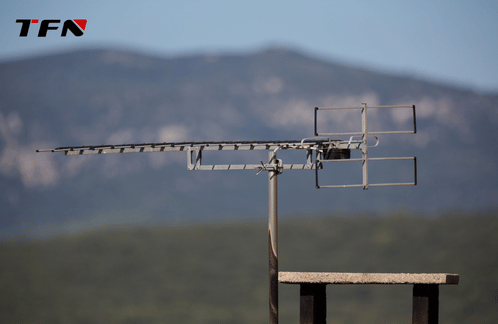Omnidirectional and directional antennas: the precise eye in spectrum analysis tests
Accurately locating signals in complex electromagnetic environments is like finding a needle in a haystack, and the spectrum analyzer in the hands of engineers is the key tool. The choice of antenna, the bridge between the instrument and the real electromagnetic world, directly determines the success or failure of the test. Omnidirectional antennas and directional antennas, two types of antennas with very different characteristics, each play an irreplaceable role in spectrum analysis tests.

Omnidirectional antennas: panoramic scanners of electromagnetic environments
Imagine that when you need to quickly understand the overview of the entire electromagnetic environment around you, omnidirectional antennas are your right-hand man:
360-degree coverage without dead angles: Omnidirectional antennas radiate and receive signals evenly in the horizontal direction, like an all-round signal searchlight. This makes it an ideal choice for initial electromagnetic environment surveys (EMI Scans). Engineers only need to set up once to get an overview of the signal strength and distribution in all directions around them.
Quickly locate the direction of the interference source (preliminary): Although it is impossible to pinpoint the location, by monitoring the changes in the signal strength received by the omnidirectional antenna at different locations, engineers can roughly determine the direction of the interference signal source and narrow the scope of investigation for further use of directional antennas.
Convenience and mobile testing: Omnidirectional antennas are usually relatively simple in structure and compact in size, making them easy to install and carry. In scenarios where mobile monitoring or vehicle-mounted spectrum testing is required, omnidirectional antennas can provide continuous, all-round signal monitoring capabilities.
In scenarios such as preliminary assessment of wireless network coverage, rapid regional locking of unknown interference sources, and indoor electromagnetic environment surveys, omnidirectional antennas combined with spectrum analyzers can efficiently provide a "panoramic map" of the environment.
Directional antenna: a signal sniper with precise positioning
When the test target is locked to a signal in a specific direction or extremely high positioning accuracy is required, the directional antenna will shine:
Excellent directional selectivity: Directional antennas concentrate energy in a relatively narrow beam for transmission and reception, with high gain and strong directivity. This enables it to effectively suppress interference signals from other directions (sidelobe suppression), greatly improve the signal-to-noise ratio (SNR), and make the target signal clearly visible on the spectrum graph.
Precisely locate the interference source: This is the core value of directional antennas. Engineers hold or rotate the directional antenna and observe the significant changes in the target signal strength on the spectrum analyzer (the strongest point is when the beam is pointing to the target), and can accurately lock the physical location of the interference source, illegal transmission source or specific communication equipment. The commonly used "amplitude comparison method" positioning is highly dependent on the directionality of the directional antenna.
Long-distance signal testing: Thanks to the high gain characteristics, directional antennas can effectively receive weak target signals from long distances, extending the test distance of the spectrum analyzer.
In scenarios that require high precision and strong anti-interference capabilities, such as spectrum monitoring, interference troubleshooting (especially deep-level interference in complex environments), RF site signal verification, illegal radio station positioning, and electromagnetic compatibility (EMC) diagnostic testing, the combination of directional antennas and spectrum analyzers is a golden pair for solving problems.
Spectrum Analyzer: The Intelligent Brain of Antenna
Whether it is an omnidirectional or directional antenna, the raw RF signal it captures requires powerful backend processing. The spectrum analyzer is the core of this:
1. Signal reception and conversion: Receive the signal input by the antenna and perform necessary attenuation, amplification and mixing.
2. Frequency and amplitude analysis: The core function is to convert the time domain signal into the frequency domain signal and accurately display the amplitude (strength) of the signal at different frequency points. This is the basis for identifying signal components and measuring levels.
3. Parameter measurement: Provides automatic measurement functions for multiple key parameters such as channel power, adjacent channel leakage ratio (ACLR), occupied bandwidth (OBW), spurious emissions, etc.
4. Data presentation and recording: Display results in the form of intuitive spectrum diagrams, waterfall diagrams, etc., and support data storage, marking and comparative analysis.
How to choose: Scenario decision tool
Choose an omnidirectional antenna: When you need to quickly understand the overall environment, conduct a large-area scanning survey, monitor on the move, or the target direction is unknown, an omnidirectional antenna is the first choice for efficiency.
Choose a directional antenna: When the task requires accurately locating the signal source, measuring weak signals in a specific direction, extracting the target signal against a strong interference background, or performing high-precision RF parameter testing, a directional antenna is indispensable.
Synergy and insight into the invisible
Omnidirectional antennas outline the overall picture, while directional antennas focus on details, and the two complement each other. Spectrum analyzers are powerful engines that interpret information captured by antennas and convert invisible electromagnetic waves into visual and quantifiable data. Understanding their respective characteristics and applicable scenarios will enable engineers to handle complex electromagnetic testing tasks with ease, whether drawing environmental maps or sniping problem signals, with accuracy and efficiency. Mastering the flexible use of this pair of "wide-angle lenses" and "sighting scopes" is a key skill in mastering the modern electromagnetic spectrum.
